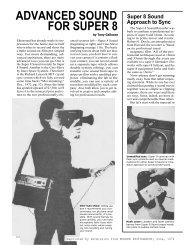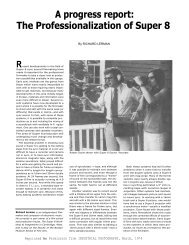Super 8 Sound Inc. - Desktop Video Group
Super 8 Sound Inc. - Desktop Video Group
Super 8 Sound Inc. - Desktop Video Group
You also want an ePaper? Increase the reach of your titles
YUMPU automatically turns print PDFs into web optimized ePapers that Google loves.
The variable speed (8 to 80fps) includes the highest speed of<br />
any <strong>Super</strong> 8 camera. The Pathe DS8 is a fully-equipped sync<br />
sound camera, with built-in 60Hz pilotone generator and 1/F<br />
sync switch. It is thus compatible with all sync recorders,<br />
cassette or reel-to-reel. The Pathe DS8 can be fitted with a<br />
400 ft. magazine with an integral take-up motor. This permits<br />
a continuous shot of 20 minutes, one of the longest available<br />
runs in any film gauge. A custom sound barney is available,<br />
making the camera very quiet in operation.<br />
S8S# CCDS8<br />
<strong>Super</strong>8 <strong>Sound</strong> Sync Cameras<br />
S8S# CCPDS8A<br />
Cinema Pathe DS8 Electronic Double <strong>Super</strong> 8 Camera<br />
—with 6-80mm Angenieux ........................................................... CCPDS8A<br />
—with 6-66mm Schneider ........................................................... CCPDS8S<br />
Cinema Pathe. DS8 Barney ........................................................... CPBARNEY<br />
Cinema Pathe DS8 400' Magazine ............................................ CP400MAG<br />
Custom Carrying Case for Camera, Lenses, etc. ......................... CPCASE<br />
Shoulder Support for Cinema Pathê DS8 ............................. BRACECP<br />
Canon DS8<br />
Although closely related structurally to the Canon Scoopic<br />
16mm, the Canon DS8 is actually a completely reworked<br />
camera. The permanently-mounted zoom lens is the same<br />
8-to-1, f/1.4 lens as is on the Canon 814E. The Canon DS8 is<br />
not built as a sync sound camera; it must be modified (e. g.<br />
by Professional Camera Repair of New York) to include a<br />
1/F sync switch. Nevertheless, as it is widely used as a sync<br />
camera with the <strong>Super</strong>8 <strong>Sound</strong> Recorder, we are including it<br />
in the Catalog. Image registration and stability are superior<br />
to any <strong>Super</strong> 8 cartridge camera. It is very noisy, and a Silencer<br />
Kit is an essential accessory. The electric eye is not<br />
through-the-lens. Other technical details are listed in the<br />
table.<br />
Canon DS8 Double <strong>Super</strong> 8 Camera ...................................................... CCDS8<br />
Bolex DS8<br />
Owners of the Bolex H8 Rex camera should consider a conversion<br />
to the Double <strong>Super</strong> 8 format. This under-$200 modification<br />
is performed by J-K Camera Engineering, Dept. S8S,<br />
5101 San Leandro St., Oakland, CA 94601.<br />
Single-System <strong>Super</strong> 8 Cameras<br />
A single-system camera is a complete sync sound location<br />
outfit, combining a sync camera and a sync recorder in one<br />
housing. <strong>Sound</strong> is recorded in sync on the magnetic edge<br />
stripe at a standard position 18 frames from the picture gate.<br />
Shot after shot is in perfect sync; slating is only useful for<br />
transfers to double-system. For one-person film crews, singlesystem<br />
is the ultimate in convenience and simplicity. All the<br />
controls are in one place; all decisions, sound and picture,<br />
can be made by one person. For these reasons, it is clear that<br />
single-system sound cameras will eventually dominate the<br />
home movie market. This is probably also the best way to<br />
introduce a beginner to sync sound filmmaking, since it postpones<br />
learning how to sync up the rushes until the student<br />
has a creative reason for wanting separate sound and picture.<br />
The <strong>Super</strong>8 <strong>Sound</strong> Recorder can be used to transfer sound<br />
from the magnetic edge stripe to fullcoat mag film for<br />
double-system editing. This gives the single-system filmmaker<br />
the best of both worlds — single-system production and<br />
double-system post-production. The <strong>Super</strong>8 <strong>Sound</strong> Recorder<br />
User's Manual, section III.K , explains how to transfer singlesystem<br />
sound to fullcoat. See the Editing section of the<br />
<strong>Super</strong>8 <strong>Sound</strong> Catalog for a discussion of single-system and<br />
double-system editing equipment.<br />
The first single-system cameras (Kodak Ektasound) are very<br />
primitive designs — 18fps only, rangefinder viewing, automatic<br />
gain control and exposure control, noisy, and with a<br />
sound hiatus between shots.<br />
The second manufacturer to enter the field, Cinema Beaulieu,<br />
built a camera (the 5008S) that is probably the highest<br />
quality <strong>Super</strong> 8 camera of any kind, single- or double-system,<br />
with sound recording specifications superior to most cassette<br />
recorders.<br />
Five or six other camera manufacturers have now built singlesystem<br />
cameras and it appears likely that most will eventually<br />
do so. These cameras are much more sophisticated than the<br />
Kodak Ektasound, and some, like the Beaulieu, are clearly<br />
ai med at professional <strong>Super</strong> 8 applications. Some run at<br />
24fps, accept 200 ft. sound cartridges, have manual gain control,<br />
headphone sound monitoring, and advanced lenses.<br />
<strong>Super</strong> 8 <strong>Sound</strong>, <strong>Inc</strong>. 11<br />
95 Harvey Street. Cambridge. Mass. 02140








